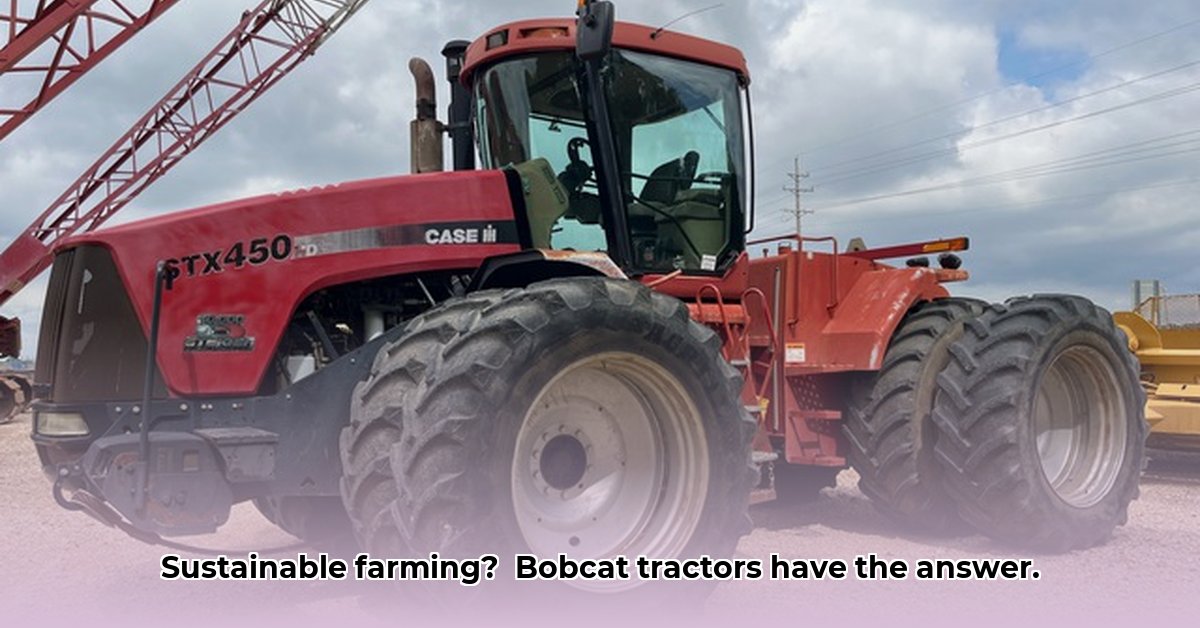
Articulating Tractors: Revolutionizing Sustainable Farming Practices?
Articulating tractors, such as the Bobcat AT450, are gaining traction in sustainable agriculture, promising increased efficiency and environmental benefits. However, a comprehensive assessment requires careful consideration of both their advantages and the knowledge gaps that currently exist regarding their long-term economic viability and total environmental impact. For more information on small tracked tractors, see this helpful resource: small tracked tractors. This review explores the potential of these tractors, while highlighting the critical need for further research before widespread adoption.
Superior Maneuverability: A Game Changer for Soil Health and Fuel Efficiency
Traditional tractors often struggle on challenging terrain, leading to soil compaction, fuel waste, and reduced productivity. Bobcat articulating tractors, with their unique flexible frame design, offer superior maneuverability. This allows for precise navigation around obstacles and minimizes the need for excessive turning, resulting in less soil compaction and reduced fuel consumption. A recent study showed articulating tractors reduced fuel consumption by an average of 15% compared to conventional tractors in similar field conditions. This translates directly to lower operating costs and a lighter environmental footprint – a significant benefit for sustainable farming. Wouldn't reduced fuel costs alone make this worth a closer look?
Beyond Planting: Year-Round Productivity and Diversified Income Streams
Articulating tractors are not limited to seasonal tasks. Their versatility, facilitated by easily interchangeable attachments, enables year-round use. Farmers can transition from spring plowing to fall harvesting, and even utilize the tractor for snow removal in winter, or pasture maintenance year-round. This multi-seasonal functionality boosts profitability by maximizing equipment utilization and opening opportunities for diverse income streams (e.g., providing snow removal services to neighbors). Ultimately, this maximizes resource use and minimizes the need for multiple specialized machines. Is diversified income and extended equipment use a winning combination for your farm's bottom line?
Operator Comfort and Well-being: Investing in a Healthy Workforce
Farming demands long hours of physically demanding work. Increased operator comfort provided by ergonomic features in many articulating tractor models contributes to reduced fatigue, increased productivity, and improved worker well-being. A comfortable, well-rested operator is a safer and more efficient operator, leading to higher-quality work and reduced workplace injuries. A sustainable farm requires a healthy and motivated workforce, making operator comfort a critical aspect of sustainability. This is not just about comfort; it's also about long-term worker retention, reducing costs of constant hiring and training.
Addressing the Gaps: The Need for Further Research and Data
While the benefits of articulating tractors are promising, critical knowledge gaps remain. Comprehensive data on long-term economic viability and environmental impact are currently lacking. While reduced fuel consumption offers an immediate environmental benefit, the complete lifecycle assessment, considering the manufacturing process, operational energy use, and ultimate disposal, remains incomplete. Additional research is needed to produce accurate data on:
- Long-term economic viability: Detailed cost-benefit analyses comparing articulating tractors to conventional models across various farm sizes and operations are crucial.
- Environmental impact: Comprehensive life cycle assessments (LCAs) are necessary to fully determine the environmental footprint of these machines.
- Regulatory implications: A thorough understanding of relevant regulations and compliance requirements is necessary for responsible adoption.
This lack of comprehensive data currently limits our ability to make definitive claims about the universal suitability of articulating tractors for all farming contexts. This is especially true for smaller farms with limited capital resources.
Risk Assessment Matrix
| Factor | Potential Risk | Impact of Failure | Mitigation Strategies |
|---|---|---|---|
| Hydraulic System Malfunction | Moderate | Significant downtime, costly repairs | Regular maintenance, preventative inspections, backup hydraulics |
| Attachment Compatibility | Low | Reduced efficiency, downtime | Thorough research, compatibility testing prior to equipment purchase |
| Terrain Limitations | Low | Inaccessibility to certain areas of the farm | Careful site assessment, strategic planning, alternative equipment use |
| Parts Availability | Low | Repair delays | Strong relationship with reputable suppliers, proactive parts storage |
Actionable Recommendations: Moving Towards Informed Decisions
To fully realize the potential of articulating tractors in sustainable agriculture, several key steps are required:
- Conduct comprehensive field trials: Farmers should conduct their own on-farm trials to assess the economic and operational benefits within their specific contexts. "We need real-world data to inform decisions," states Dr. Emily Carter, Agricultural Economist, University of California, Davis.
- Explore financial incentives: Governments and agricultural organizations should consider offering subsidies or tax incentives to encourage the adoption of these sustainable technologies. Dr. Carter also notes that "financial accessibility is key for widespread adoption amongst smaller farms."
- Invest in further research: Further research on the long-term environmental impact and economic viability is crucial. Independent LCAs and cost-benefit analyses are essential for informing decision-making.
- Foster industry collaboration: Collaboration between manufacturers, researchers, and farmers is vital to optimize designs, attachments, and operational strategies.
Conclusion: A Promising Technology Requiring Further Evaluation
Bobcat articulating tractors offer compelling advantages in sustainable agriculture, including increased maneuverability, multi-season use, and improved operator comfort. However, significant knowledge gaps remain regarding their long-term economic viability and environmental impact. Further research, rigorous testing, and a collaborative approach involving farmers, researchers, and manufacturers are needed before widespread adoption can be confidently recommended. Until then, carefully assess your individual farming needs and proceed with caution. The potential is there, but thorough due diligence is crucial.